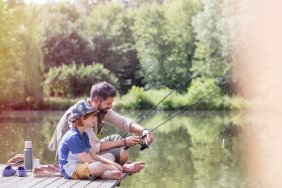 I’m sure that, by now, you’ve stocked your boat and tackle box with all the necessary—and unnecessary—tackle for the spring. The snow is melting and the temperatures are remaining consistently warmer as each day passes, and if you’re like me, the itch of getting out on the water is getting harder and harder to resist. Early spring is a delicate time of the season for bass fisherman, though, and as hard as it may be, you may have to forego tying on some of your new lures in favor of throwing out something that will appeal to the behavior and biology of bass this time of year.
I’m sure that, by now, you’ve stocked your boat and tackle box with all the necessary—and unnecessary—tackle for the spring. The snow is melting and the temperatures are remaining consistently warmer as each day passes, and if you’re like me, the itch of getting out on the water is getting harder and harder to resist. Early spring is a delicate time of the season for bass fisherman, though, and as hard as it may be, you may have to forego tying on some of your new lures in favor of throwing out something that will appeal to the behavior and biology of bass this time of year.
During early spring, bass begin to move towards shallow waters to stage during the pre-spawn period. During this time, their main prey of choice is crawfish, due to its high nutritional value—a necessity in colder temperatures—as well as the crustacean’s tendency to be slow-moving in cooler waters, which makes it an easy target. This makes crawfish-imitating lures your weapons of choice early in the season, and the number one choice is definitely a jig. Jigs are designed to mimic crawfish perfectly and while most will flip and/or pitch the lure, slowly rolling it over structure when cast far is another technique that yields results as well. Because the water temperatures are still low, bass are still lethargic, so finding a subtle lure that stays in the strike zone is crucial, and the added bonus of resembling spring bass’ favorite food doesn’t hurt either.
A ¼ oz jig in a black/blue or green pumpkin pattern is a great choice when picking a jig to target foraging spring bass. Scented plastic trailers help compound the bait’s effectiveness as well. The real beauty of the jig is the pincers that make up the trailer, which have a great action in the water no matter how you work the lure.
Jigs are perfect crawfish imitators for early spring, but, as we all know, bass can be pretty picky and sometimes won’t even cast a second glance at what we think is the perfect lure. If the jig isn’t producing fish, try switching to a small Carolina-rigged worm. Working the warm subtly on the bottom kicks of dirt and resembles emerging crawfish. For a little extra pop, try adding rattles to the worm to imitate the noises that a crawfish’s claws make.
Another effective spring lure, which many people are surprised to hear me mention, is a spinnerbait. Regarded for its speed and flash, spinnerbaits are actually very effective at enticing lethargic bass when slow-rolled along the bottom. This technique allows the bait to bounce off structure and entice the more aggressive fish. A ¾ or even a 1 oz black spinnerbait, equipped with Colorado blades and a black/blue trailer is a great option in this situation.
With spring approaching, it can be hard to stay focused and not get over-excited once we’re out on the water, making those first casts of the season. By remaining mindful of bass behavior during this transition phase and utilizing the best lures and techniques for the time of year is what will make the difference in a full livewell and an empty one. Remember that, while the bass are moving shallow and starting to feed, they’re still not very active and their feeding habits revolve around specific prey. Catering to such behavior is what will help you pull in great fish, keep your own skills sharpened, and start the season off with a bang.








